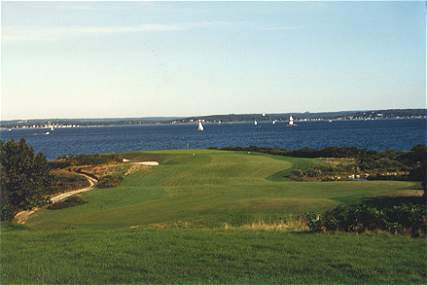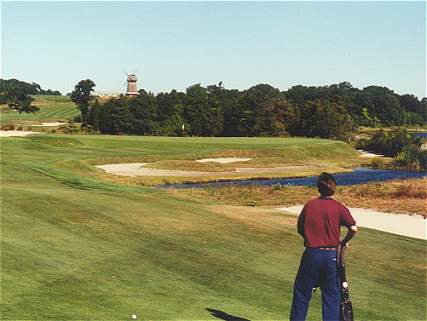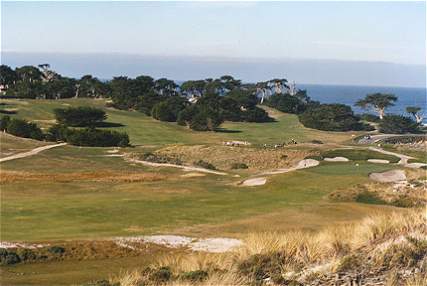Feature Interview with George Peper
October, 2000
George Peper is the Editor in Chief of GOLF Magazine, the most widely read golf magazine in the United States. Based out of New York, he has played most of the classic courses throughout the northeast. At the same time, his position has taken him around the world and he is pleased to call St. Andrews his second home. He recently published his fifth coffee table book related to golf courses, this one entitled The 500 World’s Greatest Golf Holes. With over 600 photographs from the finest courses, it is a must have.
1. Golf course architecture seems to command relatively little space in today’s golf publications as compared against other topics such as instructional or self help articles. Do you see that changing (ie do you detect more interest in architecture today than perhaps a decade ago)?
Sadly, no. Instruction remains the number-one interest of GOLF Magazine’s readers, and if anything their appetite for it is growing. I’m afraid stories on architecture are read by less than 25% of our readers, and when we ask readers what topics they’d like to see us treat more frequently, architecture ranks about 20th out of 22. I’ve always regarded golf architecture as sort of the intellectual side of golf â€those who like it are into it deeply â€but that’s a small fraternity.
2. Are there any features in course design today that you think are greatly overrated?
Hmmm ¦ I’ve always wondered what the ‘shot value’ means. Seems to me, it’s different for each of us. It’s a buzz word (or term) that’s overused and abused â€as such it’s probably also overrated as a criterion for judging holes/courses.
3. Tom Doak in The Confidential Guide states that ‘I personally think Fisher’s Island is becoming a bit overrated in the GOLF magazine rankings.’ Many of the participants at GolfClubAtlas.com disagree. What do you think?
I’d put Fisher’s Island behind Pebble Beach and Cypress Point, as my third favorite course in the world. It’s not the hardest, not the most honest, not the most strategic, and certainly not the best conditioned. But I can think of no place within 2,000 miles of my home that I’d rather play. It’s just a superb walk, 18 memorable holes, and has more breathtaking charm than anything on earth, with the possible exception of Meg Ryan.

Fishers Island is loaded with charm.
4. If time and expense weren’t considerations, which five courses would you most like to see for the first time?
My trip would be to the five most highly rated courses I’ve never played: Royal County Down, Royal Portrush, Crystral Downs, Prairie Dunes, and New South Wales.

New South Wales GC is a long way to go for a game but is worth the effort.
5. You have penned several very successful books on golf courses. Do you have any advice for those hoping to publish a book on golf courses/architecture?
Yeah, find a time machine and go back 20 years. When I wrote Golf Courses of the PGA Tour, back in 1986, there hadn’t been a golf courses book of consequence since The World Atlas of Golf (still head and shoulders the best). Since then, we’ve seen dozens, good and otherwise, and most of them haven’t sold very well. As I said, architecture is not a hot reading topic †I guess that means that any book ideas should be heavily photographic.
6. If you took a friend who had never played golf in the United States to five courses, which would they be?
National, Pinehurst #2, Winged Foot, Oakland Hills, Harbour Town. A quick walk through then history of American golf architecture.
7. What five holes (from different courses) do you always find intriguing to play?
My ideal course would have all heroic holes †cape holes, essentially †that tease each player to bite off as much as he dares. I recently played Mid Ocean for the first time, and can’t imagine a more fun hole than the par-4 fifth. Feel the same about the fourth at Yale, 17th at Cypress Point (though I think it’d be even better if they prune back that Cypress Tree a bit more), 17th at the Old Course, and 15th at Casa de Campo.

National's Cape hole
8. Who is your favourite author on the subject of golf course architecture (and you can only pick one!)?
My favorite architecture author is a fairly obscure Englishman named Patric Dickinson. If you’ve read his ‘A Round of Golf Courses,’ you know why.
9. What course is a personal favourite with which perhaps the readers may not be familiar? What do you like about it so much?
Again, Fishers Island. Also Maidstone. And Yale. (Back in 1972, I went to Yale Graduate School in search of PhD in comparative literature â€but the real attraction was the golf course. Once it was under snow, I dropped out.) Finally, my own course, Sleepy Hollow, which is just a terrific walk. It gets attention for the par-3 16th hole, overlooking the Hudson (and the truth is all four par-3s are scenic and fun), but the strength of the course is in the par 4s â€great variety, and not a breather in the bunch.

Maidstone has it all.
10. Which are your five favorite green complexes on the Old Course at St. Andrews?
Sorry, I’ve played the Old Course 20 times, but I still don’t know it well enough to answer that one.

Even the practice putting field at St. Andrews is awesome!
11. Who are your three favourite architects of all time and why?
I don’t have three favorite architects. My one favorite is C.B. Macdonald, and by extension Seth Raynor â€never played a course of theirs I didn’t love. By contrast, I refuse to get on the Donald Ross bandwagon. I realize that modern mowing equipment and methods have something to do with this, but I’m sorry, greens like those at Pinehurst #2 and Dornoch are, in my view, severe to the point of silliness. Only great shots will hold them and leave makeable putts â€good shots are tossed aside and end up where bad shots usually finish. That ain’t good design.

Macdonald and Raynor teamed well at Piping Rock.
12. How do you think the period in course architecture (1985-2000) will be viewed in fifty years’ time?
In one sense, there are more good and great courses being built now than at any time since the 1920s. But it’s also true that, in the U.S. at least, there are more courses of every kind being built. This period may be viewed as the era of entrepreneurship (or profiteering), when hundreds of developers tried to capitalize on a perceived growth in demand. Some did, others did not.
13. The 8th at Fishers Island is a favorite of yours. What about that hole makes it more appealing to you than others on the course?
I like # 8 because it’s a hole where you can make 3 or 8 â€a reachable par five, lined on both sides with trouble from which there is no recovery. Few holes are better at separating monkeys from men â€especially in a headwind.
14. In what single aspect does your personal ballot most markedly differ from GOLF’s final tabulation for their bi-annual world top 100 (i.e., perhaps your ballot features more heathland courses, more links courses, perhaps the courses are shorter, etc.)?
I’ve never analyzed it, but I suspect the courses highest on my list are short on distance and long on charm â€beautiful scenery, rolling doglegs rather than straight, runways, cozy green sites, and putting surfaces that require imagination as much as touch. With a few exceptions, I also tend to like old courses better than modern ones. I don’t mind blind shots â€they actually help me, since I can’t find the pins with my approaches anyway. I do like the links and seaside courses â€that’s probably my biggest bias. In fact, I’d be hard pressed to name a course in my top 10 that isn’t within a mile of the sea.

Short on length, long on charm, rolling doglegs, cozy green sites, on the Ocean - Cypress Point has it all.
15. You have a flat in St. Andrews. Which are your five favorite courses in Fife to play?
I’ve added brand-new Kingsbarns immediately to second place, behind the Old Course. Then I guess I’d have to say Crail, Elie, and the New Course.

16. GOLF Magazine’s rankings use the ‘I know it when I see it’ criterion (i.e., no ratings ‘formula’) for its ballot system. Has GOLF ever explored a more formuliac approach or is the task simply too subjective?
Ever since we started rating courses, in 1979, we’ve felt the ‘I know it when I see it approach’ is best. Yes, GOLF Magazine is an authority, but we’re nor authoritarian â€who are we to define what constitutes a good course? It’s different for everyone. Thus, we try to select experienced, discerning panelists, and let them make their judgments as they wish â€giving ‘A’ to courses they feel should be in the Top 10, B for the Top 50, C for the Top 100, D for the Top 200, E for top 300 and F for ‘doesn’t belong on the ballot.’ Then we take a grade point average of the votes each course gets, to establish the rankings. As such, we have an objective summary of subjective opinions. We will never impose a formula, as Golf Digest tries to do.
17 You have had the opportunity to travel and be first hand at a number of very special golf events. Do you recall a particular course set-up/design that impressed you for almost seeming to encourage the players to play great golf?
No particular course. I think all good courses should ‘root’ for the player by minimizing the questions he asks on the tee, offering plenty of definition, and thereby encouraging him to play with confidence rather than fear. This is one of the reasons I’ve never warmed to Pine Valley, as it does just the opposite. Among current courses, I don’t like Old Marsh, The Medalist, and The Ocean Course, for the same reason. I don’t mean that courses should be easy â€just give a welcoming feeling rather than the opposite. The genius of the Old Courses is that most people finish a round there saying ‘I could have scored a lot better,’ but they rarely do. Among the current architects, I think Rees Jones and Tom Fazio do the best job of talking to golfers in a straightforward, supportive way.
18. You have just published another book entitled The 500 World’s Greatest Golf Holes. If you hadn’t arbitrarily decided to do 250 par fours, 125 par threes, and 125 par fives, what do you think the mix of holes would have been?
I suspect we would have had more par fours. Think about it: only half the book â€250 of the holes â€are par fours, while on most golf courses, between 10 and 14 holes are par fours. So statistically, it was harder for a par four to make the list. That said, my own list would probably include more threes and fives; fives because of the usual risk-reward involved â€the thrill of getting home in two (or suffering a big number); threes because of the immediacy of completing the tee-to-green assignment in one shot â€appeals to my congenital impatience.
The End








